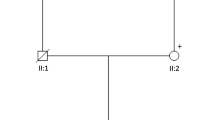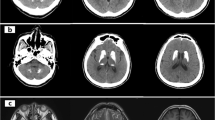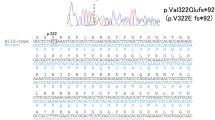Abstract
Basal ganglia calcification (striatopallidodentate calcifications) can be caused by several systemic and neurological disorders. Familial Idiopathic Basal Ganglia Calcification (IBGC, “Fahr” disease’), is characterized by basal ganglia and extrabasal ganglia calcifications, parkinsonism and neuropsychiatric symptoms. Because of an increased use of neuroimaging procedures, calcifications of the basal ganglia are visualized more often and precociously. In 1999, a major American family with IBGC was linked to a locus on chromosome 14q (IBGC1). Another small kindred, from Spain, has also been reported as possibly linked to this locus. Here we report the main findings of the first 30 candidate genes sequenced at the IBGC1 locus during the process of searching for a mutation responsible for familial IBGC. During the sequencing process, we identified a heterozygous nonsynonymous single nucleotide polymorphism (exon 20 of the MGEA6/c-TAGE gene) shared by the affected and not present in the controls. This SNP was randomly screened in the general population (348 chromosomes) in a minor allele frequency to 0.0058 (two heterozygous among 174 subjects). Another variation in this gene, in the exon 9, was found in the Spanish family. However, this variation was extremely common in the general population. Functional and population studies are necessary to fully access the implications of the MGEA6 gene in familial IBGC, and a complete sequencing of the IBGC1 locus will be necessary to define a gene responsible for familial IBGC.
Similar content being viewed by others
References
Brodaty, H., Mitchell, P., Luscombe, G., Kwok, J. J., Badenhop, R. F., McKenzie, R., et al. (2002). Familial idiopathic basal ganglia calcification (Fahr” disease) without neurological, cognitive and psychiatric symptoms is not linked to the IBGC1 locus on chromosome 14q. Human Genetics, 110, 8–14.
Comtesse, N., Niedermayer, I., Glass, B., Heckel, D., Maldener, E., Nastainczyk, W., et al. (2002). MGEA6 is tumor-specific overexpressed and frequently recognized by patient-serum antibodies. Oncogene, 21, 239–247.
Comtesse, N., Reus, K., & Meese, E. (2001). The MGEA6 Multigene family has the active locus on 14q and least nine psudogenes on different chromosomes. Genomics, 75(1–3), 1–6.
Freudenberg-Hua, Y., Freudenberg, J., Kluck, N., Cichon, S., Propping, P., & Nothen, M. M. (2003). Single nucleotide variation analysis in 65 candidate genes for CNS disorders in a representative sample of the European population. Genome Research, 13(10), 2271–2276.
Fujita, D., Terada, S., Ishizu, H., Yokota, O., Nakashima, H., Ishihara, T., et al. (2003). Immunohistochemical examination on intracranial calcification in neurodegenerative diseases. Acta Neuropathologica, 105, 259–264.
Geschwind, D. H., Loginov, M., & Stern, J. M. (1999). Identification of a locus on chromosome 14q for idiopathic basal ganglia calcification (Fahr disease). American Journal of Human Genetics, 65, 764–772.
Lhatoo, S. D., Perunovic, B., Love, S., Houlden, H., & Campbell, M. J. (2003). Familial idiopathic brain calcification—A new and familial alpha-synucleinopathy? European Neurology, 49, 223–226.
Macias, M. J., Hyvonen, M., Baraldi, E., Schultz, J., Sudol, M., Saraste, M., et al. (1996). Structure of the WW domain of a kinase-associated protein complexed with a proline-rich peptide. Nature, 382, 646–649.
Macias, M. J., Wiesner, S., & Sudol, M. (2002). WW and SH3 domains, two different scaffolds to recognize proline-rich ligands. FEBS Letters, 513, 30–37.
Manyam, B. V. (2005). What is and what is not ‘Fahr” disease’. Parkinsonism & Related Disorders, 11(2), 73–80.
Morita, M., Tsuge, I., Matsuoka, H., Ito, Y., Itosu, T., Yamamoto, M., et al. (1998). Calcification in the basal ganglia with chronic active Epstein–Barr virus infection. Neurology, 50, 1485–1488.
Oliveira, J., Sobrido, M. J., Hopfer, S., Spiteri, E., Klepper, J., Gilbert, J., et al. (2004). Genetic heterogeneity in Familial Idiopathic basal Ganglia Calcification (“Fahr” disease’). Neurology, 63, 2165–2167.
Rozen, S., & Skaletsky, H. (2000). Primer3 on the WWW for general users and for biologist programmers. Methods in Molecular Biology, 132, 365–386.
Sansom, M. S. P., & Weinstein, H. (2000). Hinges, swivels and switches: the role of pralines in signaling via transmembrane α-helices. TiPS, 21, 445–451.
Schmidt, U., Mursch, K., & Halatsch, M. E. (2005). Symmetrical intracerebral and intracerebellar calcification (“Fahr” disease’). Functional Neurology, 20(1), 15.
Schwarzbraun, T., Vincet, J. B., Schumacher, A., Geschwind, D. H., Oliveira, J., Windpassinger, C., et al. (2004). Cloning of TULIP1, a novel CpG island associated, brain expressed candidate gene for 14q13-linked neurological phenotypes and its murine homologue. Genomics, 84(3), 577–586.
Shakibai, S. V., Johnson, J. P., & Bourgeois, J. A. (2005). Paranoid delusions and cognitive impairment suggesting Fahr” disease. Psychosomatics, 46(6), 569–572.
Sobrido, M. J., & Geschwind, D. H. (2002). Genetics of familial idiopathic basal ganglia calcification (FIBGC). In S.-M. Pulst (Ed.), Genetics of movement disorders (pp. 443–448). San Diego: Academic Press.
Sobrido, M. J., Hopfer, S., & Geschwind, D. H. (2002). Idiopathic basal ganglia calcification. GeneReviews: Genetic Disease Online Reviews. www.geneclinics.org.
Sudol, M., Krzystof, S., & Russo, T. (2001). Functions of WW domains in the nucleus. FEBS Letters, 490, 190–195.
Usener, D., Schadendorf, D., Kock, J., Dubel, S., & Eichmuller, S. (2003). cTAGE: A cutaneous T Cell Lymphoma associated antigen family with tumor specific splicing. The Journal of Investigative Dermatology, 121, 198–206.
Author information
Authors and Affiliations
Corresponding author
Rights and permissions
About this article
Cite this article
Oliveira, J.R.M., Sobrido, M.J., Spiteri, E. et al. Analysis of Candidate Genes at the IBGC1 Locus Associated with Idiopathic Basal Ganglia Calcification (“Fahr” Disease’). J Mol Neurosci 33, 151–154 (2007). https://doi.org/10.1007/s12031-007-0030-7
Received:
Accepted:
Published:
Issue Date:
DOI: https://doi.org/10.1007/s12031-007-0030-7




